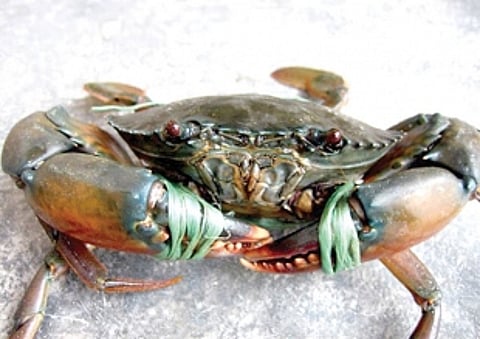

Post the COVID-19-induced lockdown, business in Goa is gradually coming together in a cooperative form. Crab and shrimp farming are being taken up in a more professional manner as the business is lucrative and profitable. Crab farming along with other aquaculture activities like mussel and shrimp farming are picking up in Goa with more and more locals opting for this mode of business.
‘Kurlio’ or crab is a highly priced, much sought-after seafood at restaurants along the coastal belt and is a big hit with tourists. Among domestic tourists the ‘tandoori’ crab is most popular and is a highly priced item on the menus of most seafood restaurants in Goa. Among Goans the lip-smacking ‘crab xacuti’, ‘crab xec-xec’ and stuffed crab are relished.
For crab and shrimp farming business potential is immense with reasonable investment. Shrimps and mussels is the ‘renewable hidden gold’ provided to Goans by nature, which has been overlooked for decades. Unfortunately, Goans are after quick money, be it in tourism or mining which have been overexploited and have now left thousands of locals in the doldrums with dead investments.
Goa is gifted with over 100 kilometers of coastline and is planning to harness the coast as well as its main rivers; Mandovi, Zuari, Terekhol, Chapora, Kushavati and the Sal whose backwaters and brackish waters are the ultimate breeding ground for crab, shrimp and mussel farming.
Flynn Remedios co-founder of Goemcho Goenkar, an NGO, is helping Goans to take up this project in their backyard.
“The pandemic has proved that one should not put all his eggs in one basket. It is important to hedge your bets and investments. Aquaculture, if properly encouraged, supported and managed by the Government and its agencies is a goldmine for Goa. Labour and approvals is the only hitch right now. If the government can provide one-window clearances and ensure a system of cheap labour by providing ID cards to labourers from other states so that they are not harassed by over enthusiastic activist groups, aquaculture can be a gold mine. It is a profitable, workable business and Goa has just the right environment and natural resources for this business,” said Flynn Remedios.
However, the high initial investment was a damper for most locals willing to take up crab farming in their villages. Besides the high cost of labour and the anti-migrants activism by some groups in the State had made crab farming very expensive and not competitive enough when compared to say Sindhudurg district of Maharashtra and in Kerala, says Netta D’Souza, a resident of Nuvem who is keen on starting crab culture in the area.
“We were sceptical about the business and did not want to invest in farm implements etc, but our local MLA provided us the equipment including a tractor free of cost. We have started home farming since April last year and now plan to get into aquaculture,” said Netta D’Souza, resident of Nuvem village.
Obtaining permissions from local bodies is another issue in Goa and even if they get permissions, local activists play spoilsport, said a spokesperson for Goemcho Goenkar, adding that coastal land that is most suitable for crab farming is owned by communities and obtaining permission from them is a nightmare as activists start objecting and protesting even before an entrepreneur can start his business.
Sushant Gaonkar also from Nuvem said, “I tried shrimp farming two years ago but it did not work too well because I didn’t have the technical knowhow. Today, we are being trained by Goemcho Goenkar to carry out shrimp farming in a professional way. We will launch our shrimp farm next month after completing the formalities.”
Two crab farms will be a reality soon in Nuvem. Another location shortlisted for crab farming is ponds and water bodies in Curchorem, said Sheetal Naik of Goemcho Goenkar. The NGO is sourcing crab seeds or crablets from the Marine Products Export Development Authority (MPEDA) hatchery in Tamil Nadu which mass produces seeds and is one of the few mud hatcheries in the world.
Nilesh Govekar of Nirankal, Bethoda in Shiroda is undergoing training in crab culture. “We were not aware of the benefits and financials of aquaculture. However, two meetings with volunteers of Goemcho Goenkar convinced us that aquaculture and crab culture in particular is a very lucrative business. It takes 2-3 months initially for setup with a total investment of about a lakh to start with, but one can earn three times the investment in less than a year,” said Govekar.
The scylla oceanica species of mud crabs are preferred as this variety of crab grows to a maximum size of 1.5 kg and will not cause any damage to bunds or fencing arrangements in the culture system. The average weight of this crab varies from 500 gms to 900 gms, which is the ideal size for local sale.
The cost works out to Rs 3-4 per seed and each seed can generate Rs 1000 to Rs 1500 after the nine month period on harvesting. Another variety of crab can grow quicker, but requires a specialised, artificial environment, which is expensive to set up, says Flynn Remedios of Goemcho Goenkar.
Besides, the scylla oceanica species of crab can be harvested in estuaries, backwaters and coastal areas as well as artificially created ponds or trenches. They can survive easily on fish surplus, fish waste or rough fish for feed, which is not very expensive and easily available in the State.
Goemcho Goenkar is conducting seminars and training programmes across the State on crab, mussel, shrimp and fresh water fish farming, along with kitchen farming and home horticulture. The first seminars were held recently at Ponda and Margao. They plan to hold such seminars at Shiroda and Curchorem soon.